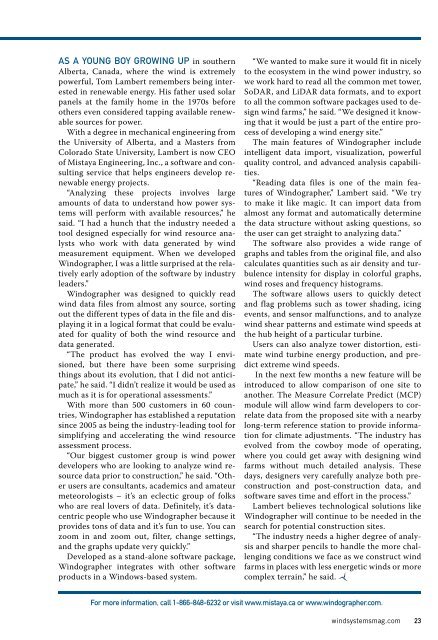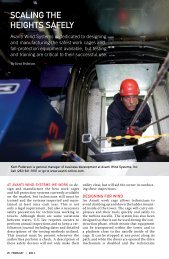download pdf - Wind Systems Magazine
download pdf - Wind Systems Magazine
download pdf - Wind Systems Magazine
You also want an ePaper? Increase the reach of your titles
YUMPU automatically turns print PDFs into web optimized ePapers that Google loves.
AS A YOUNg bOY gROWiNg UP in southern<br />
Alberta, Canada, where the wind is extremely<br />
powerful, Tom Lambert remembers being interested<br />
in renewable energy. His father used solar<br />
panels at the family home in the 1970s before<br />
others even considered tapping available renewable<br />
sources for power.<br />
With a degree in mechanical engineering from<br />
the University of Alberta, and a Masters from<br />
Colorado State University, Lambert is now CEO<br />
of Mistaya Engineering, Inc., a software and consulting<br />
service that helps engineers develop renewable<br />
energy projects.<br />
“Analyzing these projects involves large<br />
amounts of data to understand how power systems<br />
will perform with available resources,” he<br />
said. “I had a hunch that the industry needed a<br />
tool designed especially for wind resource analysts<br />
who work with data generated by wind<br />
measurement equipment. When we developed<br />
<strong>Wind</strong>ographer, I was a little surprised at the relatively<br />
early adoption of the software by industry<br />
leaders.”<br />
<strong>Wind</strong>ographer was designed to quickly read<br />
wind data files from almost any source, sorting<br />
out the different types of data in the file and displaying<br />
it in a logical format that could be evaluated<br />
for quality of both the wind resource and<br />
data generated.<br />
“The product has evolved the way I envisioned,<br />
but there have been some surprising<br />
things about its evolution, that I did not anticipate,”<br />
he said. “I didn’t realize it would be used as<br />
much as it is for operational assessments.”<br />
With more than 500 customers in 60 countries,<br />
<strong>Wind</strong>ographer has established a reputation<br />
since 2005 as being the industry-leading tool for<br />
simplifying and accelerating the wind resource<br />
assessment process.<br />
“Our biggest customer group is wind power<br />
developers who are looking to analyze wind resource<br />
data prior to construction,” he said. “Other<br />
users are consultants, academics and amateur<br />
meteorologists – it’s an eclectic group of folks<br />
who are real lovers of data. Definitely, it’s datacentric<br />
people who use <strong>Wind</strong>ographer because it<br />
provides tons of data and it’s fun to use. You can<br />
zoom in and zoom out, filter, change settings,<br />
and the graphs update very quickly.”<br />
Developed as a stand-alone software package,<br />
<strong>Wind</strong>ographer integrates with other software<br />
products in a <strong>Wind</strong>ows-based system.<br />
“We wanted to make sure it would fit in nicely<br />
to the ecosystem in the wind power industry, so<br />
we work hard to read all the common met tower,<br />
SoDAR, and LiDAR data formats, and to export<br />
to all the common software packages used to design<br />
wind farms,” he said. “We designed it knowing<br />
that it would be just a part of the entire process<br />
of developing a wind energy site.”<br />
The main features of <strong>Wind</strong>ographer include<br />
intelligent data import, visualization, powerful<br />
quality control, and advanced analysis capabilities.<br />
“Reading data files is one of the main features<br />
of <strong>Wind</strong>ographer,” Lambert said. “We try<br />
to make it like magic. It can import data from<br />
almost any format and automatically determine<br />
the data structure without asking questions, so<br />
the user can get straight to analyzing data.”<br />
The software also provides a wide range of<br />
graphs and tables from the original file, and also<br />
calculates quantities such as air density and turbulence<br />
intensity for display in colorful graphs,<br />
wind roses and frequency histograms.<br />
The software allows users to quickly detect<br />
and flag problems such as tower shading, icing<br />
events, and sensor malfunctions, and to analyze<br />
wind shear patterns and estimate wind speeds at<br />
the hub height of a particular turbine.<br />
Users can also analyze tower distortion, estimate<br />
wind turbine energy production, and predict<br />
extreme wind speeds.<br />
In the next few months a new feature will be<br />
introduced to allow comparison of one site to<br />
another. The Measure Correlate Predict (MCP)<br />
module will allow wind farm developers to correlate<br />
data from the proposed site with a nearby<br />
long-term reference station to provide information<br />
for climate adjustments. “The industry has<br />
evolved from the cowboy mode of operating,<br />
where you could get away with designing wind<br />
farms without much detailed analysis. These<br />
days, designers very carefully analyze both preconstruction<br />
and post-construction data, and<br />
software saves time and effort in the process.”<br />
Lambert believes technological solutions like<br />
<strong>Wind</strong>ographer will continue to be needed in the<br />
search for potential construction sites.<br />
“The industry needs a higher degree of analysis<br />
and sharper pencils to handle the more challenging<br />
conditions we face as we construct wind<br />
farms in places with less energetic winds or more<br />
complex terrain,” he said.<br />
For more information, call 1-866-848-6232 or visit www.mistaya.ca or www.windographer.com.<br />
windsystemsmag.com 23




